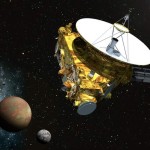Sees Pluto
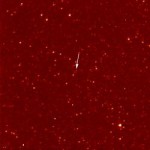 The Long Range Reconnaissance Imager (LORRI) takes its first photos of Pluto from 4.2 billion km (2.6 billion miles) away. At this distance Pluto is just a faint point of light among the stars.
The Long Range Reconnaissance Imager (LORRI) takes its first photos of Pluto from 4.2 billion km (2.6 billion miles) away. At this distance Pluto is just a faint point of light among the stars.
Finding Pluto in this dense star field really was like trying to find a needle in a haystack. LORRI passed this test with flying colors, because Pluto’s signal was clearly detected at 30 to 40 times the noise level in the images.
Jupiter rendezvous
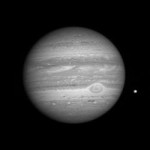 New Horizons rendezvous with Jupiter begins with black-and-white photos of Jupiter and infrared images of its moon Callisto. The probe is 81 million km (50 million miles) from the planet.
New Horizons rendezvous with Jupiter begins with black-and-white photos of Jupiter and infrared images of its moon Callisto. The probe is 81 million km (50 million miles) from the planet.
Our ground team has worked very hard to get to this point. Now the curtain is rising on the next stage of Jupiter-system exploration. It’s exciting!
Observes solar wind
New Horizons’ SWAP instrument sends back data on the solar wind around Jupiter. From a distance of 40 million miles, it observes an immense structure of compressed, dense, hot ionized gas that forms in the solar wind, called a co-rotating interaction region.
These solar wind structures collide with the magnetospheres of planets and, we believe, cause major variations in their structures. Because it has the largest magnetosphere in the solar system, the effects of the solar wind at Jupiter could have significant implications for all the planets.
Io eruption
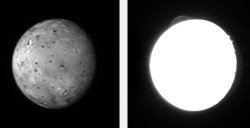 From 4 million km (2.5 million miles) away, New Horizons’ LORRI instrument photos Io’s Tvashtar volcano erupting. Jupiter’s tidal interaction with Io heats it up and causes it to be volcanically active. The bright photo shows Tvashtar erupting a huge dust plume at the 11 o’clock position. The bumps at the 2 o’clock position are tall mountains. The darker photo shows surface features of Io.
From 4 million km (2.5 million miles) away, New Horizons’ LORRI instrument photos Io’s Tvashtar volcano erupting. Jupiter’s tidal interaction with Io heats it up and causes it to be volcanically active. The bright photo shows Tvashtar erupting a huge dust plume at the 11 o’clock position. The bumps at the 2 o’clock position are tall mountains. The darker photo shows surface features of Io.
This is the best image of a large volcanic plume on Io since the Voyager flybys in 1979.
Little Red Spot
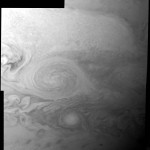 New Horizons’ LORRI snaps a picture of the Little Red Spot from 3 million km (1.8 million miles).
New Horizons’ LORRI snaps a picture of the Little Red Spot from 3 million km (1.8 million miles).
These LORRI images of the Little Red Spot are amazing in their detail. They show the early stages of this newly reddened storm system with a resolution that far surpasses anything available until now.
Europa
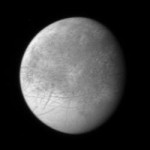 At a distance of 3.1 million km (1.9 million miles), New Horizons’ LORRI takes this picture of Europa. Covered in ice, Europa is about the size of Earth’s moon, with a diameter of 3,130 kilometers (1.945 miles).
At a distance of 3.1 million km (1.9 million miles), New Horizons’ LORRI takes this picture of Europa. Covered in ice, Europa is about the size of Earth’s moon, with a diameter of 3,130 kilometers (1.945 miles).
Ganymede
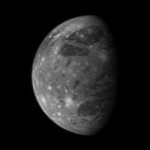 New Horizons’ LORRI snaps this image of Ganymede, Jupiter’s largest moon from a distance of 3.5 million km (2.2 million miles). Dark patches of ancient terrain are broken up by swaths of brighter, younger material, and the entire icy surface is peppered by more recent impact craters that have splashed fresh, bright ice across the surface. With a diameter of 5,268 kilometers (3,273 miles), Ganymede is the largest satellite in the solar system.
New Horizons’ LORRI snaps this image of Ganymede, Jupiter’s largest moon from a distance of 3.5 million km (2.2 million miles). Dark patches of ancient terrain are broken up by swaths of brighter, younger material, and the entire icy surface is peppered by more recent impact craters that have splashed fresh, bright ice across the surface. With a diameter of 5,268 kilometers (3,273 miles), Ganymede is the largest satellite in the solar system.
Jupiter gravity boost
 New Horizons makes its closest approach to Jupiter at a distance of 2.3 million km (1.4 million miles) passing through an aim point just 500 miles across in order to get a gravity assist that will boost its speed toward Pluto. The probe gains almost 14,000 km/h (9,000 mph) accelerating to over 83,600 km/h (52,000 mph). It has traveled 800 million km (500 million miles).
New Horizons makes its closest approach to Jupiter at a distance of 2.3 million km (1.4 million miles) passing through an aim point just 500 miles across in order to get a gravity assist that will boost its speed toward Pluto. The probe gains almost 14,000 km/h (9,000 mph) accelerating to over 83,600 km/h (52,000 mph). It has traveled 800 million km (500 million miles).
We’re on our way to Pluto. The swingby was a success; the spacecraft is on course and performed just as we expected.
Io’s eruptions
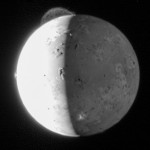 At a distance of 2.5 million km (1.5 million miles) from Io, New Horizons takes a photo of three volcanic eruptions taking place: Tvashtar’s 290-km (180-mile) high dust plume at the 11 o’clock position, Prometheus’ 60-km (40-mile) high plume at 9 o’clock, and Masubi’s eruption appearing as a bright spot near the bottom on the night side.
At a distance of 2.5 million km (1.5 million miles) from Io, New Horizons takes a photo of three volcanic eruptions taking place: Tvashtar’s 290-km (180-mile) high dust plume at the 11 o’clock position, Prometheus’ 60-km (40-mile) high plume at 9 o’clock, and Masubi’s eruption appearing as a bright spot near the bottom on the night side.
Jupiter’s rings
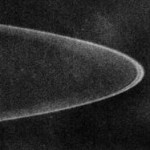 NASA releases a photo of Jupiter’s narrow ring measuring about 1,000 km (600 miles) wide with a fainter sheet of material inside it. A planetary astronomer suggests that the ring’s largest boulders are corralled into a narrow belt by the influence of Jupiter’s two innermost moons. The ring also appears to darken in the middle, a possible hint that a smaller, undiscovered moon is clearing out a gap. The faint glow extending in from the ring, the “halo,” is likely caused by fine dust that diffuses in toward Jupiter.
NASA releases a photo of Jupiter’s narrow ring measuring about 1,000 km (600 miles) wide with a fainter sheet of material inside it. A planetary astronomer suggests that the ring’s largest boulders are corralled into a narrow belt by the influence of Jupiter’s two innermost moons. The ring also appears to darken in the middle, a possible hint that a smaller, undiscovered moon is clearing out a gap. The faint glow extending in from the ring, the “halo,” is likely caused by fine dust that diffuses in toward Jupiter.
This is one of the clearest pictures ever taken of Jupiter’s faint ring system. The ring looks different from what we expected it has usually appeared much wider.
A midnight plume
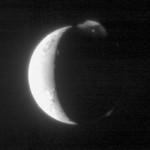 Another photo shows Io’s volcano Tvashtar erupting at the 1 o’clock position. The plume is about 330 km (200 miles) high and shows an asymmetrical and complicated wispy texture with incandenscent lava shown as the bright point of light. Another plume, likely from the volcano Masubi, is illuminated by Jupiter at the 5 o’clock position. A third and much fainter plume, barely visible at the 2 o’clock position, could be the first plume seen from the volcano Zal Patera.
Another photo shows Io’s volcano Tvashtar erupting at the 1 o’clock position. The plume is about 330 km (200 miles) high and shows an asymmetrical and complicated wispy texture with incandenscent lava shown as the bright point of light. Another plume, likely from the volcano Masubi, is illuminated by Jupiter at the 5 o’clock position. A third and much fainter plume, barely visible at the 2 o’clock position, could be the first plume seen from the volcano Zal Patera.
New Horizons and Io continue to astonish us with these unprecedented views of the solar system’s most geologically active body.
Pluto’s different features
 NASA releases a series of photos as the New Horizons probe approaches showing areas of intermediate brightness and also very bright and very dark surface features. The probe is 4.7 billion km (2.9 billion miles) from Earth and 39 million km (24 million miles) from Pluto.
NASA releases a series of photos as the New Horizons probe approaches showing areas of intermediate brightness and also very bright and very dark surface features. The probe is 4.7 billion km (2.9 billion miles) from Earth and 39 million km (24 million miles) from Pluto.
Even though the latest images were made from more than 30 million miles away, they show an increasingly complex surface with clear evidence of discrete equatorial bright and dark regions—some that may also have variations in brightness. We can also see that every face of Pluto is different and that Pluto’s northern hemisphere displays substantial dark terrains, though both Pluto’s darkest and its brightest known terrain units are just south of, or on, its equator. Why this is so is an emerging puzzle.
More terrain revealed
 NASA releases a series of photos of Pluto as the New Horizons probe approaches. The close approach hemisphere that the probe will pass by shows the greatest variation in surface features. The probe is 4.7 billion km (2.9 billion miles) from Earth and just 25 million km (16 million miles) from Pluto.
NASA releases a series of photos of Pluto as the New Horizons probe approaches. The close approach hemisphere that the probe will pass by shows the greatest variation in surface features. The probe is 4.7 billion km (2.9 billion miles) from Earth and just 25 million km (16 million miles) from Pluto.
This system is just amazing. The science team is just ecstatic with what we see on Pluto’s close approach hemisphere: Every terrain type we see on the planet—including both the brightest and darkest surface areas —are represented there, it’s a wonderland!
Charon’s dark pole
 NASA releases a photo of Charon showing a dark region near its north pole.
NASA releases a photo of Charon showing a dark region near its north pole.
The unambiguous detection of bright and dark terrain units on both Pluto and Charon indicates a wide range of diverse landscapes across the pair. . . . And about Charon—wow—I don’t think anyone expected Charon to reveal a mystery like dark terrains at its pole. Who ordered that?
Speeds up
New Horizons fires its thrusters for 23 seconds speeding up about a half mile per hour in order to perfect its course through the Pluto system. Without the adjustment, the probe would have arrived 20 seconds late and 114 miles (184 kilometers) off-target from the spot where it will measure the properties of Pluto’s atmosphere. Those measurements depend on radio signals being sent from Earth to New Horizons at precise times as the spacecraft flies through the shadows of Pluto and Pluto’s largest moon, Charon. The probe is 16 million km (10 million miles) from the Pluto system and about 4.75 billion km (2.95 billion miles) from Earth.
This maneuver was perfectly performed by the spacecraft and its operations team. Now we’re set to fly right down the middle of the optimal approach corridor.
Two faces of Pluto
 NASA releases photos that show Pluto’s two different faces. The right photo shows a series of four evenly spaced dark spots along the equator. The left photo shows the hemisphere the probe will view as it flies by.
NASA releases photos that show Pluto’s two different faces. The right photo shows a series of four evenly spaced dark spots along the equator. The left photo shows the hemisphere the probe will view as it flies by.
It’s a real puzzle—we don’t know what the spots are, and we can’t wait to find out.
Path clear
 After a detailed search for dust clouds, rings, and other potential hazards, the New Horizons team decides the spacecraft will remain on its original path through the Pluto system instead of making a late course correction to detour around any hazards. Because the probe is traveling at 49,600 km/h (30,800 mph), a particle as small as a grain of rice could be lethal.
After a detailed search for dust clouds, rings, and other potential hazards, the New Horizons team decides the spacecraft will remain on its original path through the Pluto system instead of making a late course correction to detour around any hazards. Because the probe is traveling at 49,600 km/h (30,800 mph), a particle as small as a grain of rice could be lethal.
We’re breathing a collective sigh of relief knowing that the way appears to be clear. The science payoff will be richer as we gather data from the optimal flight path, as opposed to having to conduct observations from one of the back-up trajectories
Pluto is red-brown
 New Horizons’ RALPH instrument confirms that Pluto is reddish brown probably caused by hydrocarbon molecules that are formed when cosmic rays and solar ultraviolet light interact with methane in its atmosphere and on its surface.
New Horizons’ RALPH instrument confirms that Pluto is reddish brown probably caused by hydrocarbon molecules that are formed when cosmic rays and solar ultraviolet light interact with methane in its atmosphere and on its surface.
Pluto’s reddish color has been known for decades, but New Horizons is now allowing us to correlate the color of different places on the surface with their geology and soon, with their compositions. This will make it possible to build sophisticated computer models to understand how Pluto has evolved to its current appearance.
Enters safe mode
At 1:54 pm New Horizons’ autonomous autopilot recognizes a problem, stops communicating with mission control on Earth, switches from the main to the backup computer and puts the probe into safe mode. It then begins to send information to engineers to help diagnose the problem. At 3:15 pm communication is restored. At 4:00 pm the team meets to resolve the problem and restore the probe to its flight plan. The probe is not able to collect science data at this time.
Back on track
New Horizons resumes normal operations on its main computer. The team determines that the problem was that the main computer was overloaded due to a timing conflict in the spacecraft command sequence. The computer was tasked with receiving a large command load at the same time it was engaged in compressing previous science data. The main computer responded precisely as it was programmed to do, by entering safe mode and switching to the backup computer. Thirty observations were lost during the recovery period, but they did not affect any critical observations.
I’m pleased that our mission team quickly identified the problem and assured the health of the spacecraft. Now – with Pluto in our sights – we’re on the verge of returning to normal operations and going for the gold.
